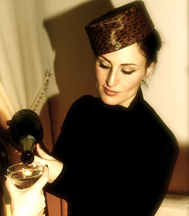We’re going to take it easy until Monday (as should you—happy Thanksgiving, everyone!), but we’re pleased to open this holiday weekend with the first installment in a new recurring feature, The Cladrite Interview.
 And we’re doubly pleased that the subject of our inaugural interview is the charming and talented Lesley M. M. Blume, author of Let’s Bring Back: An Encyclopedia of Forgotten-Yet-Delightful, Chic, Useful, Curious, and Otherwise Commendable Things from Times Gone By, a delightful collection of words, practices, attitudes, and traditions from recent decades that Blume feels (and we generally agree) should never have been allowed to fall by the wayside or out of the mainstream.
And we’re doubly pleased that the subject of our inaugural interview is the charming and talented Lesley M. M. Blume, author of Let’s Bring Back: An Encyclopedia of Forgotten-Yet-Delightful, Chic, Useful, Curious, and Otherwise Commendable Things from Times Gone By, a delightful collection of words, practices, attitudes, and traditions from recent decades that Blume feels (and we generally agree) should never have been allowed to fall by the wayside or out of the mainstream.
Inspired by her column of the same name at the Huffington Post, Let’s Bring Back is a breezy trip back in time that proves refreshing indeed for those of us drawn to the past, who wouldn’t necessarily change places with our parents’ (and grandparents’) generation, but do have an appreciation for the lives they led.
The book also features contributions from such notables as designer Kate Spade; filmmakers James L. Brooks and Nora Ephron; media icons Arianna Huffington and Ted Koppel; interior decorator Jonathan Adler, chef Daniel Boulud and others.
And found in the pages of Ms. Blume’s delightful volume are, we’re pleased to say, our own pet bring-backs: the use of the word “pictures” to refer to movies, and telephone exchanges, whose evocative qualities are sorely missing in today’s telephone listings (mind you, we didn’t contribute to the book; Ms. Blume came up with those on her own—we were just glad to learn she agrees with us).
We asked Ms. Blume about her relationship with the past, whether she feels life was necessarily better then than now, and how her appreciation for relics of days gone by impact her life today.
What initially sparked your interest in life as it was once lived?I’ve always been a history-oriented person. When I was a kid, other little girls dressed as Cinderella and Snow White for Halloween; I always wanted to be Cleopatra or Queen Elizabeth. Let’s Bring Back is just a natural extension of my personal life. I wear a lot of vintage clothing and hats, collect vintage books, listen to music on records players, and prefer dinner parties to status updates.
Do you consider yourself to be a nostalgic person, in the sense that, as Merriam Webster puts it, you yearn “for a return to or of some past period”?I don’t yearn for a return to the past. I am very happy being a 21st century woman with a full range of opportunities available to me. Even my icon, Diana Vreeland, another incurable nostalgist, had to admit to the advantages of living in the era of penicillin. But I do wish to preserve certain rituals and adornments as we move into a digital age. Let’s Bring Back is about cherry-picking the best the past has to offer, and bringing those elements into the future with us.
Would you, if given the opportunity, opt to live in another decade, another era, and if so, which one?The 1940s, when the world emerged from despair into hope again. It also marked the beginning of modernity as we recognize it today. It must have been a fascinating point of transition to experience.
Merriam-Webster’s primary definition for “nostalgia” is “the state of being homesick.” Does the past feel like home to you?In some ways, yes. But in others, not at all. If any of us woke up in another decade, we’d feel like aliens. I don’t think we really realize the extent to which we’re creatures of our own times.
I’m more interested in what came before me. Aesthetically speaking, I don’t really give a hoot about the ‘80s or ’90s, although Mad Men rekindled my interest in my early childhood in the 1970s. So many of the design elements in the show’s sets and costuming—not to mention social rituals—were still very much a part of the landscape when I was a kid. So that show seriously resonated with me.
Do you live what you consider to be a vintage lifestyle? How does this manifest itself?A vintage lifestyle is one that honors the integrity of objects and pastimes from bygone eras, instead of casting them aside for the sake of pursuing novelty. This can arise from creating a physical world of vintage objects around you, or simply have a vintage mindset. So much of vintage lifestyle is about attitude and one’s manner. So, yes, I very much live a vintage lifestyle.
If you could pick one example from your book to, with a snap of your fingers, immediately bring back into use, which would it be?Discreet voices. I hate hearing people’s one-sided cell-phone conversations.
Read More »



